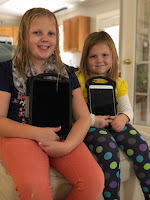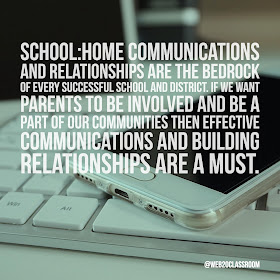Unless you just haven’t noticed, trees, lights and ornaments are going up on businesses and homes all over the place. Commercials on television highlight sweaters, coffee and fireplaces. It’s hard to ignore we are in the holiday season.
And, if you are like me you mind turns to the long list of things you have to get for everyone in your life. Gifts for kids, family, friends, the mailman, bus driver, front office staff. You can start feel pretty overwhelmed. It's easy to get caught up in the hustle and bustle and forget about that one person on your list that you need to take care of the most.
Yourself.
Educators spend all year taking care of everyone else. Students in the classroom. Leadership in the office. Parents. Community members. It can become physically and mentally demanding. Late December is a great time of year to rest, spend time with family and friends and recharge your educator batteries. It’s important for every educator to take some time to mentally, emotionally and physically reset before you go into the new year.
Here are some ways you can recharge your professional self before the new year starts and give yourself some gifts that really matter.
Anytime Learning
One of the best gifts you can give yourself is the gift of making time for professional learning. Schools and districts just simply don’t have the means to personalize your PD. But you do! There are so many great options out there to take control of you PD and learn what you want and need anytime, anywhere.
Edweb- I’ve said it once and I’ll keep saying it. Edweb is amazing. Free webinars nearly everyday. Archives of everything they’ve done. There is no reason not to be checking out what Edweb has to offer for your professional learning needs.
Classroom 2.0 Live and Archives- Every Saturday there is a free webinar for educators over at Classroom 2.0. They cover all sorts of topics and their archive and resource list is extensive. Best of all you can subscribe to their video podcast feed and never miss an episode.
Edchat Interactive-Most webinars are passive. Sit and get. Edchat Interactive aims to change that. Everyone is on video and you can create small groups to discuss and debate. Check out their archive too. (A little shameless promotion with this one as I am one of the founders.)
Books
I am lucky. Spending lots of time on airplanes (or waiting for delayed planes) gives me lots of time to read. I mix up my reading between the latest educational research and stuff that I just find interesting. Here are 3 books I read this year that are a good escape and can still influence you as an educator.
Confessions of an Advertising Man -It might be unusual for a book about advertising to end up on a list for educators but if you are at all interested in creativity then this book should be at the top of your list.
-It might be unusual for a book about advertising to end up on a list for educators but if you are at all interested in creativity then this book should be at the top of your list.
The Life Changing Magic Of Not Giving A _____ -I know the title of this one will give some pause and even some of the language used in might be offputting to others, this is a book that should be in your personal library. If you want to figure out what really matters in your personal and professional life (and what educator doesn’t?) then definitely pick this one up.
Pioneer Girl Perspectives: Exploring Laura Ingalls Wilder -I am a huge fan of the Little House series and this book was a fascinating read into the reclusive author and why her stories of pioneer life are even more important today.
-I am a huge fan of the Little House series and this book was a fascinating read into the reclusive author and why her stories of pioneer life are even more important today.
Here are more books that you might be interested in.
Mindfulness and Reflection
While not new, meditation and taking time to look inward can be one of the best gifts you can give yourself. And it using mindfulness and reflection can also boost learning in the classroom.
Headspace-This is the app I use and works great. It is free to use but you can pay to unlock additional features. Download it to your mobile device to get a little reflection time where ever you are.
Smiling Mind-Here is another app to take a look at as well. What I like about this one is they have a specific series all about how to get started and use mindfulness in the classroom.
TED Talks
A list on gifts to give yourself wouldn’t be complete without some TED Talks. We’ve all probably seen one or several of these but have you sought out the more obscure ones? The funny ones? Sometimes a little humor (and learning) is what we need to get going again.
This Is What Happens When You Reply To Spam Email
The Story Of The 404 Error Page
How To Use A Paper Towel
I Got 99 Problems...And Palsy Is Just One
A Theory Of Everything
And, if you are like me you mind turns to the long list of things you have to get for everyone in your life. Gifts for kids, family, friends, the mailman, bus driver, front office staff. You can start feel pretty overwhelmed. It's easy to get caught up in the hustle and bustle and forget about that one person on your list that you need to take care of the most.
Yourself.
Educators spend all year taking care of everyone else. Students in the classroom. Leadership in the office. Parents. Community members. It can become physically and mentally demanding. Late December is a great time of year to rest, spend time with family and friends and recharge your educator batteries. It’s important for every educator to take some time to mentally, emotionally and physically reset before you go into the new year.
Here are some ways you can recharge your professional self before the new year starts and give yourself some gifts that really matter.
Anytime Learning
One of the best gifts you can give yourself is the gift of making time for professional learning. Schools and districts just simply don’t have the means to personalize your PD. But you do! There are so many great options out there to take control of you PD and learn what you want and need anytime, anywhere.
Edweb- I’ve said it once and I’ll keep saying it. Edweb is amazing. Free webinars nearly everyday. Archives of everything they’ve done. There is no reason not to be checking out what Edweb has to offer for your professional learning needs.
Classroom 2.0 Live and Archives- Every Saturday there is a free webinar for educators over at Classroom 2.0. They cover all sorts of topics and their archive and resource list is extensive. Best of all you can subscribe to their video podcast feed and never miss an episode.
Edchat Interactive-Most webinars are passive. Sit and get. Edchat Interactive aims to change that. Everyone is on video and you can create small groups to discuss and debate. Check out their archive too. (A little shameless promotion with this one as I am one of the founders.)
Books
I am lucky. Spending lots of time on airplanes (or waiting for delayed planes) gives me lots of time to read. I mix up my reading between the latest educational research and stuff that I just find interesting. Here are 3 books I read this year that are a good escape and can still influence you as an educator.
Confessions of an Advertising Man
The Life Changing Magic Of Not Giving A _____ -I know the title of this one will give some pause and even some of the language used in might be offputting to others, this is a book that should be in your personal library. If you want to figure out what really matters in your personal and professional life (and what educator doesn’t?) then definitely pick this one up.
Pioneer Girl Perspectives: Exploring Laura Ingalls Wilder
Here are more books that you might be interested in.
Mindfulness and Reflection
While not new, meditation and taking time to look inward can be one of the best gifts you can give yourself. And it using mindfulness and reflection can also boost learning in the classroom.
Headspace-This is the app I use and works great. It is free to use but you can pay to unlock additional features. Download it to your mobile device to get a little reflection time where ever you are.
Smiling Mind-Here is another app to take a look at as well. What I like about this one is they have a specific series all about how to get started and use mindfulness in the classroom.
TED Talks
A list on gifts to give yourself wouldn’t be complete without some TED Talks. We’ve all probably seen one or several of these but have you sought out the more obscure ones? The funny ones? Sometimes a little humor (and learning) is what we need to get going again.
This Is What Happens When You Reply To Spam Email
The Story Of The 404 Error Page
How To Use A Paper Towel
I Got 99 Problems...And Palsy Is Just One
A Theory Of Everything














